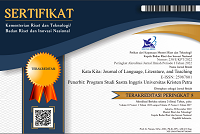Childhood Trauma Aftermath on the Adult BoJack Horseman
(1) English Department, Faculty of Humanities and Creative Industries, Petra Christian University, Siwalankerto 121-131, Surabaya 60236
(2) English Department, Faculty of Humanities and Creative Industries, Petra Christian University, Siwalankerto 121-131, Surabaya 60236
(*) Corresponding Author
Abstract
In recent decades, adult animation has garnered its own audience due to its mix of dark humor and slash of reality. One popular series is BoJack Horseman. The show intrigues me because throughout its six seasons, it manages to show how childhood trauma deeply affects BoJack, the main character, as an adult. In this study, we want to analyze the root causes of BoJack’s childhood trauma and the coping mechanisms he did. The findings of this research suggest that there are two main reasons: maltreatment from caretakers and loss of a loved one. Furthermore, there are four forms of maltreatment from his parents: hurtful words, broken marriage, domestic abuse, and gaslighting/guilt tripping. To cope with his trauma, BoJack used four strategies: escapism, dark humor, suicide attempt, and professional help. Through a combination of these four strategies, BoJack was forced to deal with his childhood trauma to become a better person.
Keywords
Full Text:
PDFReferences
Angelakis, I., Austin, J. L., & Gooding, P. (2020). Association of childhood maltreatment with suicide behaviors among young people: A systematic review and meta-analysis. JAMA Network Open. 3(8):2012563. doi:10.1001/jamanetworkopen.2020.12563
Child Welfare Information Gateway. (2019). Long-term consequences of child abuse and neglect. Washington, DC: U.S. Department of Health and Human Services, Administration for Children and Families, Children’s Bureau.
Igorevna, O. O. (2015). Escapism: current studies and research prospects in contemporary psychology. Austrian Journal of Humanities and Social Sciences, 3-4(1), 103-105.
Lewis, J. (2014.) Essential cinema: An introduction to film analysis. Wadsworth, Cengage Learning.
MacLeod, A. (2020, October 21). Using dark humor to lighten up. Curiosity Shots. Retrieved May 11, 2022, from https://curiosityshots.com/dark-humor-to-lighten-up/#:~:text=From%20a%20psychological%20perspective%2C%20dark%20humor%20is%20simply,an%20emotional%20experience%20less%20clouded%20by%20negative%20sentiments.
McCrory, E. J., & Viding, E. (2015). The theory of latent vulnerability: Reconceptualizing the link between childhood maltreatment and psychiatric disorder. Development and Psychopathology, 27(2), 493–505. https://doi.org/10.1017/s0954579415000115
Ni, P. (2017). How to successfully handle gaslighters & stop psychological bullying. Preston Ni: Communication Coaching.
Over the shoulder shot: Everything you need to know. (n.d.). Nashville Film Institute. Retrieved May 19, 2022, from https://www.nfi.edu/over-the-shoulder-shot/
Patterson, E. (2022, May 10). Signs of a guilt trip & how to respond. Choosing Therapy. Retrieved June 6th, 2022, from https://www.choosingtherapy.com/guilt-trip/
Stark, S. W. (2015). Volume 5 Essay: Emotional Abuse. In P. Moglia (Ed.), Psychology and Behavioral Health (pp. 1975-1977, 4th ed.). Salem Press at Greyhouse Publishing.
Wells, P. (1998). Understanding animation. Routledge.
Yang, M., Font, S. A., Ketchum, M., & Kim, Y. K. (2018). Intergenerational transmission of child abuse and neglect: Effects of maltreatment type and depressive symptoms. Children and Youth Services Review, 91, 364–371. doi: 10.1016/j.childyouth.2018.06.036
DOI: https://doi.org/10.9744/katakita.10.2.380-387
Refbacks
- There are currently no refbacks.
Supported by:
Indexed in:
Tools:
Stats (installed since 17 December 2018)
View My Stats













